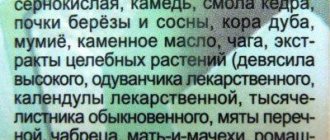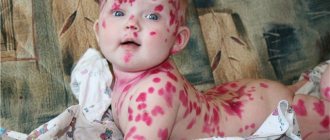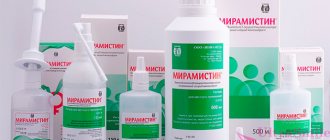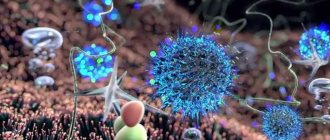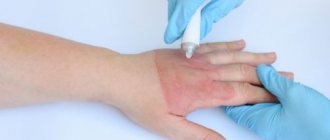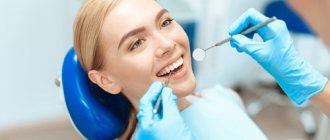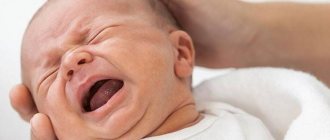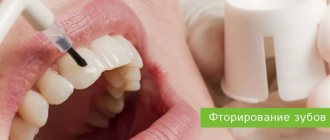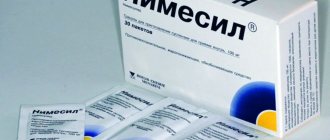External hygiene product Malavit has a wide spectrum of action. The solution is made exclusively on the basis of natural, environmentally friendly components. The product has good anti-inflammatory properties and antiseptic effects. This allows it to be used in the complex treatment of various diseases.
Malavit: release form and composition
The hygienic natural elixir is available in 30 or 50 ml bottles. They are made of dark glass and equipped with a special dropper, which simplifies the process of using the product.
Malavit solution contains more than 100 different components. The balanced formula guarantees high effectiveness of treatment, which is confirmed by testing and in practice. The malavit solution, the instructions confirm this, does not contain ethyl alcohol. It contains no dyes or preservatives.
In the production of the product, purified ionized water is used, which is an information matrix. Other important components in the composition:
- Copper ions provide wound healing effects. They relieve inflammation and have antimicrobial properties.
- Lactic acid. The organic product accelerates recovery processes and promotes skin cell renewal.
- Gum, which is a special additive that has protective properties and can reduce pain.
- Siberian cedar resin, whose common name is “resin”. A characteristic feature of the substance is its biological activity, which guarantees an enhanced therapeutic effect.
- Pine and birch buds, which contain beneficial essential oils and tannins. They enhance the antimicrobial effect, which promotes wound healing.
- Oak bark, characterized by astringent and analgesic effects.
- Birch chaga mushroom, which has antiseptic properties and the ability to strengthen local immunity.
- Shilajit, which promotes tissue regeneration.
- Extracts of various medicinal plants.
Inflammation of the gums: causes, symptoms, treatment and prevention
Traditional methods of combating gum inflammation
To combat inflammation and pain at home, there is a wide range of medicinal plants.
The effectiveness of recipes has been tested for centuries. However, as is the case with the use of products sold in pharmacies, to achieve the desired result and to avoid side effects, it is recommended to first consult a dentist. Most folk remedies are decoctions, tinctures and compresses. Among the most popular plants it is worth highlighting the following:
- Oak bark, St. John's wort - produce a general strengthening effect.
- Chamomile, calendula - produce a pronounced antibacterial effect.
- Sage, aloe leaves, yarrow herb - relieve inflammation and relieve pain.
In most cases, plants and herbs are used at first, when gingivitis has not yet caused complications. If they occur, then it is more advisable to use medications. It is better to prepare products in small portions (several times), as they quickly deteriorate. Below we present to your attention several simple and proven recipes.
Recipe No. 1: aloe compress
Aloe leaves have disinfectant and antiseptic properties. The compress is prepared as follows:
- Take a fresh leaf of the plant.
- Remove the spines and outer shell from it.
- Cut lengthwise.
- Apply to the place where the gum is inflamed.
- Hold for 10 – 15 minutes.
The compress is recommended to be used in the morning and evening. To achieve a more effective elimination of inflammation, you can make a concentrated infusion of the juice in boiling water and use it for rinsing.
Recipe No. 2: oak bark decoction
Oak bark perfectly fights bacteria and eliminates inflammation. To make a decoction, you will need 2 tbsp. l. crushed raw materials and 0.5 liters of water. Boil over low heat for 10 - 15 minutes and use daily as a rinse until the condition of the gums returns to normal.
Recipe No. 3: sea buckthorn oil compress
Sea buckthorn oil is commercially available, but it can also be prepared at home:
- Take 1 kg of sea buckthorn berries.
- Extract the juice using a juicer.
- Place in a dark place for several days.
- Use a spoon to remove any floating oil from the surface.
Sea buckthorn oil compresses are effective in treating any inflammatory processes. It’s easy to use: soak gauze in the raw material and apply to the site of inflammation for 15 – 20 minutes.
Recipe No. 4: decoction of pine buds
A good remedy for bleeding gums. All you need is 2 tbsp. l. young kidneys and 500 grams of water. Simmer for 10 minutes, then cool and filter. Rinse your mouth for 5 – 10 minutes.
Recipe No. 5: propolis infusion
Propolis is excellent for restoring tissue joints and has antibacterial properties. To prepare, you need to place the raw material in a dark bottle and fill it with a 70% alcohol solution so that it covers the propolis by about 1 cm. After a day, you need to strain and mix 20 drops of the tincture with 200 grams of water (for 1 procedure). Rinse three times a day.
Indications for use of the product
The plant-based Malavit solution is indicated for the treatment of damage to the surface of the skin and mucous membranes. When used, it is possible to reduce swelling and improve microcirculation in tissues. Thanks to the antiseptic properties of the product, it is possible to fight harmful microorganisms on the surface of the skin. The drug enhances the effect of other antiseptic drugs.
A solution of malavit is prescribed, the instructions for use confirm this, for treatment:
- Oral cavity.
- Nasal mucosa.
- External genitalia.
Since the drug does not cause resistance in pathogenic microorganisms, it can be used for a long time.
Elixir malavit is effective in the complex treatment of diseases in various areas:
- Otolaryngology: otitis, tonsillitis, sinusitis.
- Gynecology: vulvo-vaginitis, candidiasis, etc.
- Urology: cystitis, urethritis, etc.
- Dentistry: periodontal disease, gingivitis, stomatitis.
The effectiveness of the drug has been proven in practice in the treatment of acne and fungal infections. The product is widely used in traumatology and sports medicine in the treatment of bruises, hematomas and muscle strains.
Contraindications of the drug
The hygiene product is well tolerated. Problems can arise only in case of intolerance to the components of the product. Since the solution has a rich composition, it is better to consult a doctor before using it. If you exclude hypersensitivity to individual components, then allergic side reactions of the body do not occur when using the drug.
Cases of overdose with malavit have not been recorded. But if the solution gets inside, you should urgently rinse the stomach and induce vomiting.
Features of treatment
The bottle must be shaken before using the product. A small sediment may be present in the elixir. Therefore, after shaking, the solution may become cloudy.
Treatment of the damaged area of skin with the solution is carried out using a cotton sponge. To enhance the effect, it is necessary to additionally cover the damaged area with polyethylene and bandage it. Application duration is from 20 minutes to 3 hours. It depends on the degree of damage and the type of specific disease.
Warming compresses are also effective. To do this, the sore spot is warmed up using a heating pad or rubbing. After that, make a compress in the usual way.
When carrying out processing, you must adhere to the following recommendations:
- In the absence of violations of the integrity of the skin and mucous membranes, it is allowed to use undiluted product.
- If there are lesions on the skin and mucous membranes, the concentrated solution should be diluted with water.
Other recommendations:
- When treating ENT diseases, dilute 5-10 drops of the elixir in 100 ml of water. The resulting solution is used to rinse the nasal passages or use it as nasal drops or gargles. Procedures are performed 3-5 times a day.
- When treating catarrhal otitis, 5 drops of the product are diluted in a teaspoon of water. The resulting solution is slightly heated and a cotton swab is moistened in it, which is placed in the ear canal. The procedure is performed 4-6 times a day.
- To normalize the vaginal microflora, douching is carried out with a solution, which is prepared at the rate of 2 teaspoons of concentrate per glass of water.
- When treating dental pathologies, the mouth is rinsed with a solution prepared from 7-10 drops diluted in a glass of water.
You can get acquainted with other recommendations by studying the instructions for using the hygiene product.
Lichen planus is a chronic polyetiological disease with rashes of papules on the mucous membranes and skin. Isolated lesions of lichen planus of the oral mucosa are observed in 75% of cases. This is one of the most common diseases of the oral mucosa.
The appearance of lichenoid rashes in the oral cavity is usually associated with emotional stress, neuropsychic shocks, and negative emotions. Disturbance of neuroendocrine regulation (early onset of menopause) is important.
The erosive-ulcerative form of lichen planus of the oral mucosa, being a precancerous disease, requires close attention and qualified treatment from the dentist. If a dentist identifies a total lesion of the oral mucosa with an erosive-ulcerative form of lichen planus, the patient is referred for inpatient treatment to a skin disease clinic.
In the hospital, as a rule, the patient receives large doses of corticosteroid drugs and other medications by mouth. At the same time, less attention is paid to the local treatment of erosive and ulcerative lesions of the oral mucosa [1-6].
The purpose of the study is to develop an effective method for treating the erosive-ulcerative form of lichen planus in a clinic with total damage to the mucous membrane of the oral cavity, gums and lips.
Material and methods
Clinical examination and treatment of patients was carried out at the Department of Diseases of the Oral Mucosa of the Department of Hospital Therapeutic Dentistry, Periodontology and Geriatric Dentistry.
We observed 7 patients (1 man and 6 women) aged from 46 to 71 years with an erosive-ulcerative form of lichen planus (see table).
Complaints upon admission
Patients complained of an unusual appearance of the oral mucosa, loss of taste, burning sensation, pain when eating and brushing teeth, roughness and tightness of the oral mucosa.
All patients had anxiety-hypnotic syndrome, negative psycho-emotional states with a tendency to depression, and cancerophobia. The disease progressed with alternating periods of remission and exacerbation. Exacerbation was always preceded by stress.
When examining the skin of 3 patients, single papules were revealed on the skin of the forearms of the hands. When examining the oral mucosa, multiple papular rashes were revealed on the dorsal surface of the tongue, the mucous membrane of the cheeks, lips, and the vestibular surface of the gums (Fig. 1, 2).
Figure 1. Lichen planus, erosive-ulcerative form. Patient A., 52 years old.
Figure 2. Lichen planus, erosive-ulcerative form. Patient B., 46 years old.
On the mucous membrane of the transitional folds of the cheeks and the ventral surface of the tongue, against the background of bright hyperemia, sharply painful extensive erosions and ulcers were detected (Fig. 3)
Figure 3. Lichen planus, erosive-ulcerative form. Patient G., 68 years old.
Treatment method
The essence of the method lies in the combined use of steroid drugs - both as a general course (prednisolone) and locally (diprospan). A set of therapeutic measures was carried out in the oral cavity. In addition, after consultation with a neuropsychiatrist, patients were prescribed daily antidepressants: fluoxetine 20 mg, 1 capsule in the morning or Cipralex - 10 mg, 1 tablet in the morning.
The course of treatment with antidepressants depended on the duration of the disease, the severity of psycho-emotional changes and was 3-6 months.
Successful treatment of patients in our group without prescribing oral prednisolone is currently not possible. But our task was to use this drug in gentle doses.
This scheme was proposed earlier by Prof. A.L. Mashkelleyson:
1. Prednisolone 0.005 g
Regimen: 1st week - 4 tablets per day, every other day;
2nd week - 3 tablets per day, every other day;
3rd week - 2 tablets per day, every other day;
4th week - 1 tablet per day, every other day.
2. Delagil 0.25 g 1 tablet 2 times a day, daily, course 4 weeks.
3. Vitamin PP 0.05 g 1 time per day, after meals, course 4 weeks.
4. Vitamin A, oil solution, 8-10 drops on rye bread 2 times a day, course 4 weeks.
Local treatment
We attached significant importance to this stage of treatment. Traumatic factors were eliminated, hygiene correction, professional hygiene, and replacement of prostheses made of dissimilar metals were carried out. Candidiasis was excluded. Antiseptic treatment of erosions and ulcers was carried out, followed by rubbing in prednisolone ointment, and after 10 minutes - Cholisal or Kamistad gel.
With preliminary premedication (sedatives, antihistamines), diprospan 1 dose and 4 ml of a 2% lidocaine solution (without a vasoconstrictor) were administered under elements of damage to the oral mucosa (foci of exudation and hyperemia, erosion, ulcers) with an insulin needle.
If necessary, the injection of diprospan was repeated after 4-6 weeks.
Characteristics of drugs
1. Cipralex, fluoxetine
Daytime antidepressants. Eliminate depressive reactions of various origins, panic disorders, anxiety, phobias. Helps improve mood.
The therapeutic effect develops after 3-4 weeks of continuous use. Does not cause sedation.
Fluoxetine
20 mg, 1 capsule in the morning, regardless of meals. Then the dose is gradually increased to 2 capsules - taken twice in the morning. The course of treatment is 3-6 months.
Cipralex
- 10 mg, 1 tablet in the morning.
2. Diprospan
Diprospan* is a glucocorticosteroid drug. International (nonproprietary) name: betamethasone*.
, Belgium.
Dosage form: suspension for injection. 1 ml of diprospan suspension contains 6.43 mg of betamethasone dipropionate and 2.63 mg of betamethasone sodium phosphate. The combined composition of the drug has significant advantages when used in clinical settings. One of the components of the drug (betamethasone sodium phosphate) is highly soluble and easily absorbed from the injection site, which provides an anti-inflammatory and analgesic effect within 1-3 hours. The other component of the drug (betamethasone dipropionate) is poorly soluble and is slowly absorbed from the depot formed at the injection site. The latter ensures a prolonged (up to 4-6 weeks) effect of the drug after administration.
Diprospan has high glucocorticosteroid activity, but unlike its predecessors (hydrocortisone, prednisolone, kenalog) it has a number of advantages:
- slight mineralocorticosteroid effect, rapid and at the same time prolonged powerful anti-inflammatory and analgesic effect;
— does not cause local fine-crystalline reactions;
- does not have a local degenerative effect on tissue;
- prescribed both once and repeatedly (if indicated).
3. Prednisolone
- a synthetic analogue of the steroid hormone of the adrenal cortex hydrocortisone. Glucocorticosteroids have anti-inflammatory, desensitizing, antiallergic, antishock and antitoxic effects.
Prescribed for neurodermatitis, dermatoses, eczema, allergic shock, etc. When treating the erosive-ulcerative form of lichen planus, it is used in combination with delagil. Prescribed with 2.5 mg and gradually reduce the dose until the drug is completely stopped.
Release form: tablets containing 0.001 g and 0.005 g of prednisolone.
4. Hingamin (delagil)
- antimalarial drug. Chingamine quickly causes the death of asexual erythrocyte forms of all types of plasmodium. The spectrum of action of hingamine is not limited to the effect on malarial plasmodium. It has an inhibitory effect on the synthesis of nucleic acids, the activity of certain enzymes, and immune processes. As a result, the drug has found wide use in the treatment of collagenosis (systemic lupus erythematosus, scleroderma, rheumatoid arthritis) and dermatoses (lichen planus). The drug is well and quickly absorbed and slowly released from the body.
Release form: tablets of 0.25 g; powder; ampoules of 5 ml of 5% solution.
In the treatment of erosive-ulcerative forms of lichen planus, it is used in combination with steroid drugs, 0.25 g 2 times a day for 1 month.
5. Nicotinic acid (vitamin PP, vitamin B3)
- belongs to the B vitamins. Nicotinic acid plays a significant role in the life of the body. It is a prosthetic group of codehydrase enzymes I and II, which act as hydrogen carriers and take part in redox processes.
Nicotinic acid is prescribed to normalize redox processes in the body and dilate blood vessels. For these purposes, vitamin PP is prescribed in the treatment of lichen planus.
Release form: powder and tablets of 0.05 g and ampoules containing 1 ml of 0.17% sodium nicotinate solution, which corresponds to 0.1% nicotinic acid. When treating lichen planus, vitamin PP is prescribed 0.05 g 1-2 times a day after meals for 1 month. Also injections of vitamin PP solution under the affected elements.
When using nicotinic acid orally on an empty stomach, redness of the face and upper half of the body, and dizziness may occur. Persons with hypersensitivity to nicotinic acid should be prescribed nicotinamide.
6. Retinol (vitamin A)
normalizes metabolic processes in the epithelium, the function of cell membranes, stimulates the regeneration of epithelial cells.
Vitamin A is found in animal products (butter, egg yolk, liver).
The daily requirement for vitamin A is 1.5 mg, or 5000 IU, for an adult.
When treating lichen planus, 8-10 drops of an oil solution of vitamin A are prescribed orally 2-3 times a day for a course of 1.5 months; locally in the form of applications of an oil solution of vitamin A to the affected areas 2-3 times a day for 15 minutes for a course of 1.5 months.
7. Oral gels Cholisal, Kamistad
Anti-inflammatory, analgesic effect.
Treatment results and discussion
After completion of the course of treatment, the patients had no complaints. When examining the oral mucosa, the disappearance of foci of exudation, hyperemia, complete epithelization of erosions, ulcers, and a significant decrease in lichenoid rashes were noted (Fig. 4).
Figure 4. Lichen planus, erosive-ulcerative form. Patient B., 46 years old. After treatment.
In 2 patients, due to stress, an exacerbation occurred 1-1.5 months after treatment (exudation, hyperemia and single small erosions appeared on the mucous membrane of the cheeks). These patients received a repeated course of general and local treatment.
When examining a group of patients 6 months after completion of the course of treatment, there were no complaints. Single papules were detected on the unchanged oral mucosa. The psycho-emotional state of the patients improved noticeably.
The treatment method we offer avoids hospitalization, which is a significant advantage. In addition, the effectiveness of local administration of diprospan makes it possible to prescribe gentle doses of prednisolone and reduce the risk of complications.
With local administration of diprospan with lidocaine, pain symptoms are quickly eliminated, which, in combination with the effect of daytime antidepressants, leads to a noticeable improvement in the psycho-emotional state of patients.
Thus, the effectiveness of treatment of the erosive-ulcerative form of lichen planus with total damage to all parts of the oral mucosa increases significantly due to the combined use of steroid drugs, as well as local therapeutic measures in the oral cavity. Our experience confirms the real possibility of treating patients with this disease in a clinic setting.
